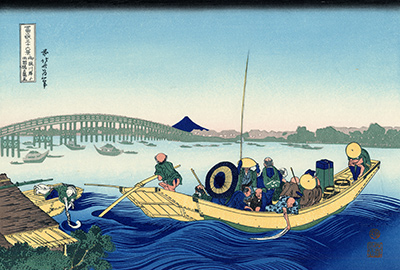Hokusai
Sunset across the Ryogoku bridge by Hokusai
Sunset across the Ryogoku bridge from the bank of the Sumida River (1830) is a woodblock colour print genre painting created by Japanese artist Katsushika Hosukai (1760-1849).
This particular painting is the twelfth view in his most famous work, the woodblock colour print collection entitled “Thirty-six Views of Mount Fiji”. Hosukai only started this collection at the age of 70 and worked on it until his death aged 88; the most famous view is that of “The Great Wave off Kanagawa”.
“Sunset across the Ryogoku bridge from the bank of the Sumida River” contrasts vivid blue waves against a pale blue river with a deep blue Mount Fiji providing a focal point against the pale sky. A boat of passengers looks out towards the bridge. It is thought that the introduction of Prussian blue synthetic dye was a strong influence on this collection of Mount Fiji views. Born in Tokyo to a family of artisans, Hosukai’s father sent him to work in a bookshop and lending library at the tender age of 12; he subsequently became an apprentice to a wood-carver at the age of 14.
He entered Katsukawa Shunsho’s studio in 1778 where he would master the art of ukiyo-e, a type of wood block printing art. Hosukai was an artist during the Edo Period (1603-1868), in which enjoyment of arts and culture was actively encouraged. Hosukai was also a leading designer of toy prints, board games and also illustrated numerous works of fiction and poetry. It is estimated that he created an estimated 30,000 works in his lifetime. Hosukai had two wives and five children, one of whom became an artist themselves. He was notoriously eccentric.
It is purported that he did not like cleaning and simply moved to a new studio when the previous one became unbearable. As was customary for Japanese artists of that time, Hosukai was known by multiple (~30) monikers throughout his lifetime. His final pseudonym “Gakyo Rojin Manji” roughly translates as “Old Man Mad About Painting” and was inscribed on his tombstone. A popular subject of Japanese art due to its spiritual and cultural significance, Mount Fiji was a personal passion of Hosukai and his legacy lives on to this day.
